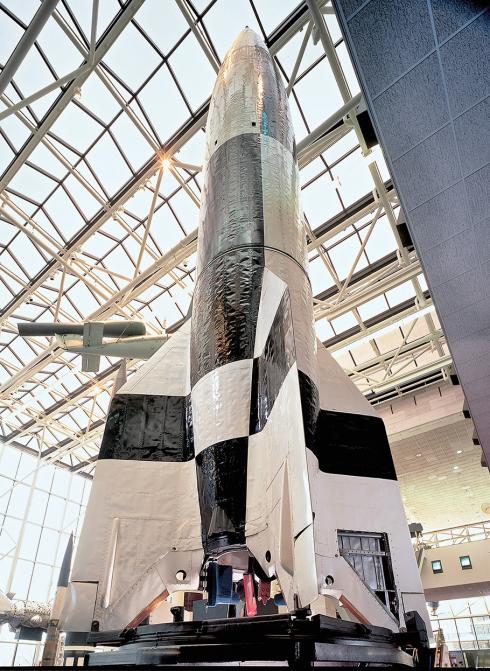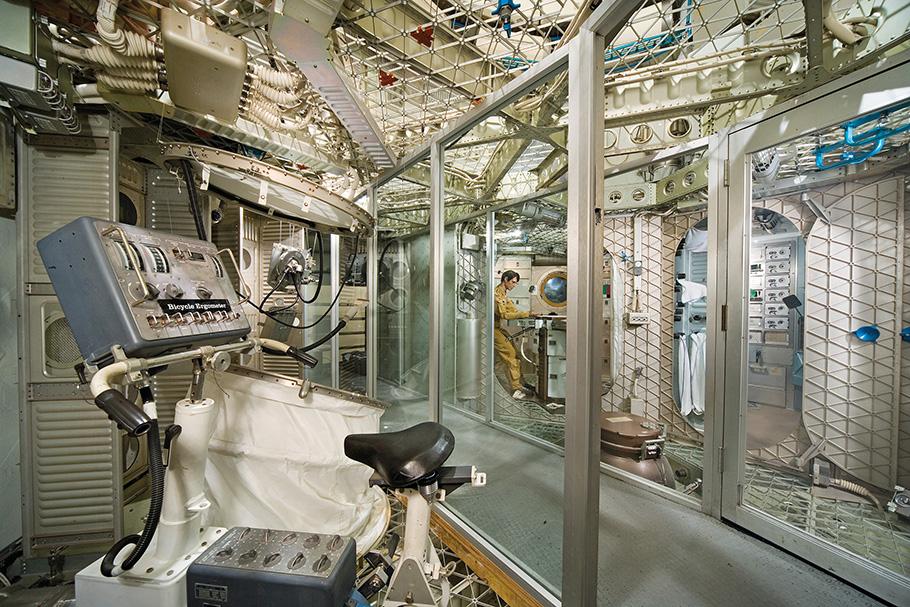A new gallery shows how spaceflight transformed our relationship with technology.
Although most of us have never left Earth, we all live in the Space Age—and the Smithsonian’s National Air and Space Museum wants to explain to you why that matters. In 2026, the Museum will open a new major gallery, RTX Living in the Space Age, which will occupy three levels in the east end of the building. The mission of the gallery is to explain the how, why, and who of the ways in which the Space Age has transformed our lives.
The significance of this new era was not lost on those who were there at its beginning. Testifying before Congress in 1959, physicist Lloyd Berkner quipped that we should drop “A.D.” from our calendar and replace it with “A.S.” (After Sputnik). By then, there were a half-dozen satellites in orbit, and there were already serious discussions about how space would become the new frontier for communications, exploration, and national defense. “Space Age” became the ubiquitous term used by advertisers to sell everything from appliances to clothes. It was synonymous with innovation, discovery, and pushing boundaries.
The human spaceflight unit in the new gallery boasts an exhibit depicting the evolution of spacesuits across the decades, including the Berkut spacesuit used by cosmonaut Aleksei Leonov during training.
Those same themes—the rapid emergence of new technologies and our expectations of what they can accomplish—will be present in the new gallery as it tells the history of the Space Age through both artifacts and human stories. The exhibition team hopes that visitors walk away with the understanding that there are consequences and vulnerabilities to Space Age technologies that challenge assumptions of convenience. Visitors will also learn that the origins of the technologies and systems we use day-to-day come from military efforts to enhance national defense.
The aesthetic of the Astroland amusement park at New York’s Coney Island was the embodiment of the optimistic futurism in the early Space Age. This image has been slightly altered to remove a Web address from the sign. (Flickr/Jorge Quinteros)
The introduction to the gallery will beckon visitors with the sight of an illuminated star that once stood at the “Astroland” amusement park in Coney Island, New York, beginning in the early 1960s. Billed as a “space-age” theme park, Astroland found its inspiration in the most fantastical expectations of the era. Visitors could ride in futuristic bubble cars and hop on a “Satellite Jet” for a simulated trip to the moon.
When visitors first enter the gallery, they will see the star from Astroland amusement park’s actual sign. This image has been slightly altered to remove a Web address from the sign.
From there, a chronological story of the Space Age begins with a more down-to-earth approach, as visitors arrive at a missile pit housing rockets and launch vehicles. The narrative begins with the Nazi V-2 rocket, a weapon built with forced labor, which was adapted by the superpowers after World War II to send the first human-made objects into Earth’s orbit. Repainted in its original color, the V-2 will join three additional launch vehicles in the missile pit: They will show how we learned to send nuclear weapons to their targets, how increasingly large and sophisticated objects were sent into orbit, and how human beings flew into space throughout the 20th and 21st centuries.
The gallery reminds us that peaceful uses of space had military origins: The Nazi V-2 missile was modified to send the first human-made objects into Earth’s orbit.
Astronauts were often the heroes of these stories. What is often unseen, though, is the fact that the effort to send humans into space requires armies of specialists, technicians, engineers, and physicians. The human spaceflight unit in the gallery will focus on those who have made astronauts’ work in space safe and fruitful. A section on spacesuits will focus on how their designers conceived of them not simply as protective garments, but as human-shaped spacecraft. Visitors will see prototypes across the decades that illustrate how design, materials, and aesthetics have evolved beyond what was initially worn by astronauts in the 1960s. And, if you consider yourself a true astronaut aficionado, you will enjoy the opportunity to walk through a back-up of the first U.S. space station, Skylab, to see how the earliest inhabitants of low Earth orbit lived.
The Space Age has transformed the way we rely on technology, particularly how we find our way. Instead of paper maps to get from one place to another, we now depend on constellations of orbiting satellites that relay highly accurate positioning, time, and navigation information to ground station complexes.
Want to be an astronaut? To see how the earliest inhabitants of low Earth orbit lived, you can tour a back-up model of Skylab, the first U.S. space station.
The data is then interpreted by ubiquitous computer software programs. Originally developed as a military aid to navigate the globe, policymakers soon saw the civilian benefits of such systems. Beneath a replica of the most recent U.S. navigation satellite, visitors will learn how the systems have expanded over time and how navigation has emerged from a primarily military endeavor to our current casual civilian use.
The Hubble Space Telescope gave us a close-up view of the universe—and the exhibit offers a close-up view of a full-scale mockup of the telescope.
Other noteworthy large artifacts on display include the structural dynamic test vehicle of the Hubble Space Telescope—a full-scale mockup built by the Lockheed Space and Missile Company in 1975 for conducting various feasibility studies. Smaller and equally compelling objects include everyday personal items that astronauts carried into space, a monitor used to track animal migration, and parts of a civil defense kit to be used in the event of a nuclear attack.
The gallery—along with its online content—will also feature the stories of the men and women who, each in their own way, shaped the Space Age. These tales include those of a Jewish engineer in the Soviet Union who led an obscure laboratory and overcame entrenched antisemitism to become the chief designer outfitting cosmonauts; a woman whose work for a U.S. Navy contractor pioneered the calculations that made our global positioning satellite system possible; and a young man whose job guarding nuclear missiles in Montana gave him new perspectives on protecting Earth and the space environment from the increasing debris that humans have deposited in orbit.
The Museum looks forward to sharing stories of those who shaped the Space Age and showing how these technologies continue to change our lives.
Cathleen Lewis is the curator of international space programs and spacesuits at the National Air and Space Museum.





